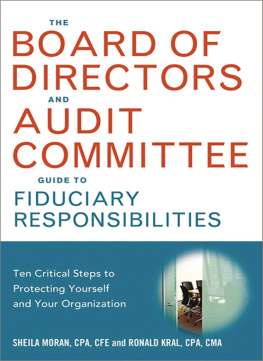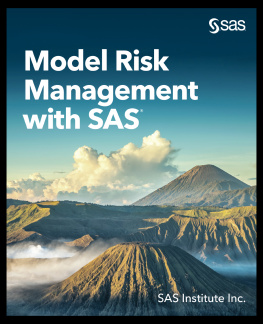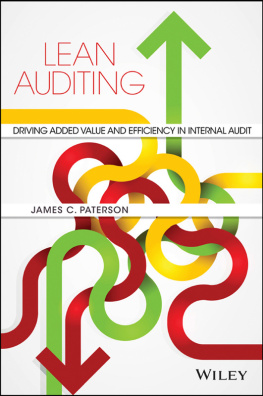Bulk discounts available. For details visit:
www.amacombooks.org/go/specialsales
Or contact special sales:
Phone: 800-250-5308
Email: specialsls@amanet.org
View all the AMACOM titles at: www.amacombooks.org
American Management Association: www.amanet.org
This publication is designed to provide accurate and authoritative information in regard to the subject matter covered. It is sold with the understanding that the publisher is not engaged in rendering legal, accounting, or other professional service. If legal advice or other expert assistance is required, the services of a competent professional person should be sought.
ISBN : 978-0-8144-3167-2 (eBook)
Moran, Sheila.
The board of directors and audit committee guide to fiduciary responsibilities : ten critical steps to protecting yourself and your organization / Sheila Moran, Ronald Kral.
p. cm.
Includes index.
ISBN 978-0-8144-3166-5 (hardcover) ISBN 0-8144-3166-6 (hardcover) 1. Directors of corporationsLegal status, laws, etc.United States. 2. ExecutivesLegal status, laws, etc.United States. 3. Audit committeesLaw and legislationUnited States. 4. Corporate governanceLaw and legislationUnited States. I. Kral, Ronald. II. Title.
KF1423.M67 2013
657.4580973dc23
2013007791
2013 Sheila Moran
All rights reserved.
This publication may not be reproduced, stored in a retrieval system, or transmitted in whole or in part, in any form or by any means, electronic, mechanical, photocopying, recording, or otherwise, without the prior written permission of AMACOM, a division of American Management Association, 1601 Broadway, New York, NY 10019.
The scanning, uploading, or distribution of this book via the Internet or any other means without the express permission of the publisher is illegal and punishable by law. Please purchase only authorized electronic editions of this work and do not participate in or encourage piracy of copyrighted materials, electronically or otherwise. Your support of the authors rights is appreciated.
About AMA
American Management Association (www.amanet.org) is a world leader in talent development, advancing the skills of individuals to drive business success. Our mission is to support the goals of individuals and organizations through a complete range of products and services, including classroom and virtual seminars, webcasts, webinars, podcasts, conferences, corporate and government solutions, business books, and research. AMA s approach to improving performance combines experiential learninglearning through doingwith opportunities for ongoing professional growth at every step of ones career journey.
Printing number
10 9 8 7 6 5 4 3 2 1
Information about External Hyperlinks in this ebook
Please note that footnotes in this ebook may contain hyperlinks to external websites as part of bibliographic citations. These hyperlinks have not been activated by the publisher, who cannot verify the accuracy of these links beyond the date of publication.

I N THE WAKE of the 2001 collapses of Enron, WorldCom, and Arthur Andersen, professionals, lawmakers, and stakeholders alike turned their focus to issues such as corporate governance, accountability, and transparency, pushing C-suite executives, managers, and board members to more closely scrutinize the inner workings of businesses. In the decade since, however, corporate malfeasance has remained in the headlines, with attention-grabbing collapses of such corporate stalwarts as Lehman Brothers, which in 2008 accounted for the largest bankruptcy in U.S. historyand nearly brought down the entire U.S. economy.
According to the 2011 Performance and Accountability Report by the U.S. Securities and Exchange Commission ( SEC ), the SEC filed 735 enforcement actions covering a broad spectrum of financial wrongdoing during the fiscal year ended September 30, 2011. This represented an 8.6 percent increase from 2010more cases than ever previously filed by the SEC s Division of Enforcement in a single fiscal year. Those enforcement cases, and those from 2010, resulted in $3.6 billion in penalties and disgorgement (i.e., the repayment of illicit gains), with many of the financial wrongdoings falling under the general oversight of audit committee activities.
Despite some notable business failures and enormous fines, boards of directors have done much to improve the accountability and transparency of the companies they oversee. In fact, strong boards and audit committees can doand have donemuch to help build great companies. Because many organizations do not impanel a separate audit committee, the entire board may be called upon to fulfill that function. Therefore, this book interchangeably uses the terms board and audit committee.
In this era of closer scrutiny and larger fines, those who sit on boards and committees must do all they can to hold management accountable for its actions. In fact, regulators and disgruntled shareholders are accelerating their efforts to hold board directors personally accountable for their actions as well as for perceived inaction in their role in overseeing management, meaning that anyone who chooses to sit on a board or audit committee can be sued if the organization or directors break the law. Directors and committee members must be thorough, independent, and able to apply their expertise when overseeing organizations, whether public or private, for-profit or nonprofit.
No organization should harbor the false impression that the full board can carry on the duties of an audit committee without ample expertise at the board level. For example, Sonora Resources Corp. reported just such a material weakness to the SEC in an annual filing, stating, We have a board which consists of the Chief Executive Officer and we do not have an audit committee. An audit committee would improve oversight in the establishment and monitoring of required internal controls and procedures. Such material weakness points to both a lack of independence at the board level and a lack of expertisesomething no organization should allow.
In another example, Buka Ventures Inc. reported a material weakness in an annual filing to the SEC , noting that [c]ertain entity level controls establishing a tone at the top were considered material weaknesses and that the company did not have a separate audit committee or a policy on fraud. The disclosure continues: There is no system in place to review and monitor internal control over financial reporting. The Company maintains an insufficient complement of personnel to carry out ongoing monitoring responsibilities and ensure effective internal control over financial reporting.
These examples point to a dangerous recipe for errors and fraud. Weak, ill-informed, and inexperienced boards and audit committees can contribute in many negative ways to the downfalls of organizations. On the other hand, strong boards and audit committees stand at the core of strong organizations.







